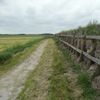The Wier dyke
Hippolytushoef
Around the 11th century the peat soil around former island Wieringen and Waddensea island Texel was badly eroded by storm floads. From then on the water threatend the lower coastal areas. Dykes were made to protect the land.
Take a look
Around the 11th century the peat soil around former island Wieringen and Waddensea island Texel was badly eroded by storm floads. From then on the water threatend the lower coastal areas. Dykes were made to protect the land. The dykes were made out of compressed seaweed and enforced with dirt. The seaweed stayed in place by wooden poles. The steep front of the dyke was a weakness. The waves banged againts the wall. Therefor the wall needed constant maintenance. A worm created another problem. The wooden poles were badly effected by the worm which led to the end of this type of dykes. During the 18th century they constructed the dykes as we know them now.
Because of the inland Waard Nieuwland a part of the seaweed dyke survived and is now a monument.
Villa Nieuwland and group accommodation the Wierschuur lies near the seaweed dyke.
Here you will find The Wier dyke
Burgerweg1777 PB Hippolytushoef Plan your route naar The Wier dyke
from your location


